Exactly How Heat Recovery Ventilation Enhances Indoor Air Top Quality and Reduces Power Costs
Heat Recovery Ventilation (HRV) systems play an essential duty in improving interior air high quality while simultaneously decreasing energy expenditures. By effectively trading stagnant interior air with fresh outdoor air, HRVs help maintain optimal moisture and lower contaminants. In addition, their capability to recuperate heat from outbound air minimizes the stress on home heating and cooling systems. As power costs remain to climb, comprehending the complete potential of HRV systems ends up being significantly crucial for homeowners and services alike.
Comprehending Heat Recovery Ventilation Equipments

Heat recovery ventilation (HRV) systems play a crucial function in enhancing interior air quality, specifically in contemporary, energy-efficient structures. These systems are created to transfer heat from the outbound stale air to the inbound fresh air, thus decreasing energy loss while maintaining suitable temperature level degrees indoors. HRVs contain a warm exchanger, followers, and ductwork, promoting the continuous circulation of air. By getting rid of interior toxins and presenting fresh air, HRVs aid to balance humidity degrees, protect against mold growth, and reduce allergens. The efficiency of HRV systems depends on their capability to recuperate as much as 80% of the warm from the tired air, promoting energy preservation while ensuring a healthy interior setting. Their assimilation is essential in attaining lasting living techniques.
The Relevance of Indoor Air Top Quality
Indoor air quality (IAQ) is an essential variable influencing the health and wellness and health of owners in any environment. Poor IAQ can cause numerous wellness concerns, consisting of respiratory problems, allergies, and tiredness. Furthermore, it can worsen status quo such as asthma. Factors contributing to low IAQ include pollutants from indoor resources like cleaning up agents, mold and mildew, and insufficient ventilation. Subsequently, maintaining great IAQ is vital for promoting a risk-free and comfy living or functioning area. Reliable methods to boost IAQ entail normal monitoring of air high quality, correct air flow systems, and lessening making use of unsafe substances indoors. By prioritizing IAQ, people can assure a much healthier environment that cultivates productivity and total quality of life.
Energy Effectiveness Conveniences of HRV Systems
Numerous house owners and structure supervisors are progressively identifying the energy efficiency advantages of heat recovery ventilation (HRV) systems. By transferring warm from tired indoor air to inbound fresh air, HRV systems considerably minimize the energy required for heating and air conditioning. This process lessens dependence on standard cooling and heating systems, leading to lower power costs. In addition, HRVs aid keep a well balanced interior environment, protecting against too much home heating or cooling down demands. The capability to recover up to 90% of the heat from outgoing air also sustains sustainability initiatives by minimizing total energy consumption. Subsequently, HRV systems contribute not just to cost financial savings yet additionally to a lowered carbon footprint, aligning with the growing emphasis on energy-efficient building techniques.
Installment and Upkeep Considerations
The effective application of heat recuperation air flow (HRV) systems requires mindful factor to consider of installment and maintenance factors to assure peak performance. Proper positioning of the HRV device is necessary, as it ought to be installed in a place that optimizes air flow while minimizing sound disruption. In addition, ductwork needs to be appropriately sized and protected to avoid power loss. Routine upkeep, including filter substitute and system cleansing, is important to secure ideal capability and indoor air quality. Proprietors ought to develop a regular maintenance timetable to identify and attend to potential concerns prior to they escalate. Cooperation with seasoned experts throughout both setup and upkeep phases can enhance the durability and performance of HRV systems, ultimately causing far better indoor atmospheres and minimized power costs.
Real-World Applications and Success Stories
Checking out real-world applications of warm recovery air flow (HRV) systems reveals their significant influence on interior air top quality and power efficiency across various settings. In property structures, home owners have reported improved air quality, causing fewer allergic reactions and respiratory problems. Schools applying HRV systems have kept in mind enhanced trainee focus and decreased absence due to much better air flow. Commercial structures, such find here as offices and retail areas, have experienced lower power expenses and raised staff member company website productivity. A company workplace in a warm climate achieved a 30% reduction in energy bills after mounting an HRV system. These success tales demonstrate that HRV innovation not just adds to much healthier environments but also gives substantial monetary benefits, making it a valuable investment for different industries.
Often Asked Questions
Can HRV Systems Decrease Irritants in Indoor Air?
The performance of HRV systems in lowering interior irritants primarily rests on their capability to filter and exchange air. HRV Heat Recovery Ventilation. By continually replacing stagnant air, these systems can greatly decrease allergen degrees throughout indoor settings

Exactly How Does Humidity Affect HRV System Efficiency?
Moisture considerably influences HRV system performance; high degrees can cause condensation, decreasing efficiency, while reduced humidity might improve air exchange. Stabilizing humidity is crucial for excellent procedure and preserving indoor air top quality.
Are HRV Solutions Noisy During Operation?
HRV systems can generate varying sound degrees throughout procedure, relying on their design and installation. Some systems operate quietly, while others might generate recognizable noise, specifically at higher air movement settings or when poorly preserved.
What Is the Ordinary Life-span of an HRV System?

Can HRV Equipments Be Utilized in All Climates?
HRV try these out systems can be made use of in different environments, however their effectiveness might vary - HRV Heat Recovery Ventilation. In severe temperatures, changes or extra systems might be essential to ensure ideal efficiency and comfort while preserving interior air high quality